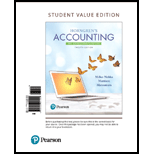
Horngren's Accounting: The Managerial Chapters, Student Value Edition (12th Edition)
12th Edition
ISBN: 9780134491509
Author: MILLER-NOBLES, Tracie L., Mattison, Brenda L., Matsumura, Ella Mae
Publisher: PEARSON
expand_more
expand_more
format_list_bulleted
Textbook Question
Chapter 15, Problem 2QC
Which of the following investments is most likely classified as a held-to-maturity debt investment?
Learning Objective 1
- 80% stock ownership in a subsidiary
- 100% ownership in voting stock of a supplier
- 10-year bonds
- None of the above
Expert Solution & Answer
Want to see the full answer?
Check out a sample textbook solution
Students have asked these similar questions
Need answer
GENERAL ACCOUNTING PROBLEM
Subject: general accounting
Chapter 15 Solutions
Horngren's Accounting: The Managerial Chapters, Student Value Edition (12th Edition)
Ch. 15 - Prob. 1QCCh. 15 - Which of the following investments is most likely...Ch. 15 - Prob. 3QCCh. 15 - A company invested $45,000 in Yale Co. stock. The...Ch. 15 - Prob. 5QCCh. 15 - Prob. 6QCCh. 15 - Prob. 7QCCh. 15 - Prob. 8QCCh. 15 - Prob. 9QCCh. 15 - Prob. 10QC
Ch. 15 - Prob. 1RQCh. 15 - Prob. 2RQCh. 15 - Prob. 3RQCh. 15 - Prob. 4RQCh. 15 - Prob. 5RQCh. 15 - Prob. 6RQCh. 15 - Prob. 7RQCh. 15 - Prob. 8RQCh. 15 - Prob. 9RQCh. 15 - Prob. 10RQCh. 15 - Prob. 11RQCh. 15 - Prob. 12RQCh. 15 - Prob. 13RQCh. 15 - Prob. 14RQCh. 15 - Prob. S15.1SECh. 15 - Prob. S15.2SECh. 15 - Prob. S15.3SECh. 15 - Prob. S15.4SECh. 15 - Prob. S15.5SECh. 15 - Prob. S15.6SECh. 15 - Prob. S15.7SECh. 15 - Accounting for debt investments Learning Objective...Ch. 15 - Prob. E15.9ECh. 15 - Prob. E15.10ECh. 15 - Prob. E15.11ECh. 15 - Accounting for equity investments Learning...Ch. 15 - Prob. E15.13ECh. 15 - Prob. E15.14ECh. 15 - Prob. E15.15ECh. 15 - Prob. E15.16ECh. 15 - Prob. E15.17ECh. 15 - Prob. P15.18APGACh. 15 - Prob. P15.19APGACh. 15 - Prob. P15.20APGACh. 15 - Accounting for debt investments Learning Objective...Ch. 15 - Prob. P15.22BPGBCh. 15 - Prob. P15.23BPGBCh. 15 - Prob. P15.24CTCh. 15 - Prob. 25CPCh. 15 - Prob. 15.1TIATCCh. 15 - Prob. 15.1DCCh. 15 - Prob. 15.1EICh. 15 - Prob. 15.1FCCh. 15 - Prob. 15.1FSC
Knowledge Booster
Learn more about
Need a deep-dive on the concept behind this application? Look no further. Learn more about this topic, accounting and related others by exploring similar questions and additional content below.Similar questions
- manufacturing cost.arrow_forwardA company acquired a trademark on January 1, 2015, for $5 million. The trademark will be used for 10 years, even though its legal life is 25 years. The company has made a commitment to sell the trademark to another firm for $300,000 at the end of 10 years. Compute the annual amortization expense for 2015, assuming the straight-line method is used. Helparrow_forwardSol This question answerarrow_forward
- choose best answerarrow_forward2 POINTarrow_forwardZeb Enterprises' corporate charter allows it to issue 3,000,000 shares of common stock. In its first year of business, Zeb sold 750,000 shares of common stock in March 2015. Zeb bought back 2,500 shares of its stock during November 2015. At December 31, 2015, how many shares of common stock are outstanding? Answerarrow_forward
- Zeb Enterprises' corporate charter allows it to issue 3,000,000 shares of common stock. In its first year of business, Zeb sold 750,000 shares of common stock in March 2015. Zeb bought back 2,500 shares of its stock during November 2015. At December 31, 2015, how many shares of common stock are outstanding?arrow_forwardWhat is the weighted average cost of capital on these financial accounting question?arrow_forwardThe Carter Corporation's next expected dividend, D1, is $2.75; its growth rate is 5.5 percent, and its stock currently sells for $40.50. New stock can be sold to net the firm $36.90 per share. a. What is Carter's percentage flotation cost? b. What is Carter's cost of new common stock?arrow_forward
- correct answer please help me general accountingarrow_forwardOn January 1, 2020, Franklin Ltd. acquired a delivery truck at a cost of $750,000. It is to be depreciated on the straight-line method over a 5-year period with no residual value. Due to a bookkeeping error, no depreciation was recognized in Franklin's 2020 financial statements. The oversight was discovered during the preparation of Franklin's 2021 financial statements. Depreciation expense on this truck for 2021 should be____.helparrow_forwardWhat is the amount of joint costs assigned?arrow_forward
arrow_back_ios
SEE MORE QUESTIONS
arrow_forward_ios
Recommended textbooks for you
 Cornerstones of Financial AccountingAccountingISBN:9781337690881Author:Jay Rich, Jeff JonesPublisher:Cengage Learning
Cornerstones of Financial AccountingAccountingISBN:9781337690881Author:Jay Rich, Jeff JonesPublisher:Cengage Learning Financial Reporting, Financial Statement Analysis...FinanceISBN:9781285190907Author:James M. Wahlen, Stephen P. Baginski, Mark BradshawPublisher:Cengage Learning
Financial Reporting, Financial Statement Analysis...FinanceISBN:9781285190907Author:James M. Wahlen, Stephen P. Baginski, Mark BradshawPublisher:Cengage Learning

Cornerstones of Financial Accounting
Accounting
ISBN:9781337690881
Author:Jay Rich, Jeff Jones
Publisher:Cengage Learning

Financial Reporting, Financial Statement Analysis...
Finance
ISBN:9781285190907
Author:James M. Wahlen, Stephen P. Baginski, Mark Bradshaw
Publisher:Cengage Learning

Financial instruments products; Author: fi-compass;https://www.youtube.com/watch?v=gvxozM3TUIg;License: Standard Youtube License